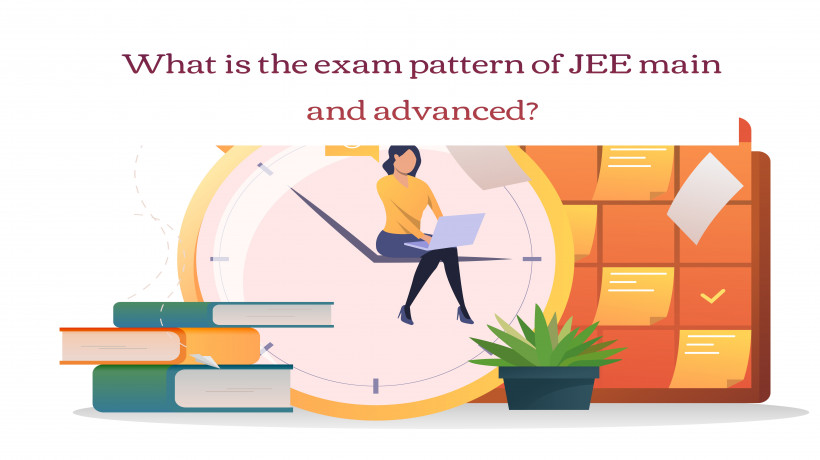What is the exam pattern of JEE main and advanced
Candidates who closely observe and follow the exam pattern, Check latest Paper Pattern JEE Main Exam, including the exam mode, type of questions, Total Marks, Exam Language.
November 19, 2021

Candidates who closely observe and follow the exam pattern will not only be able to prepare a successful study plan but they can ultimately perform well and achieve a better result in the exam. Check the JEE Pattern below!
While the JEE Main syllabus is mainly mapped according to the NCERT textbooks, NTA does prescribe a separate syllabus for JEE. It comprises topics covered in class 11th and 12th standard, including Maths, Physics, and Chemistry.
The questions asked in the JEE Main exam are easy but require a lot of intelligent work, practice, and adequate preparation. One of the significant challenges generally faced by students is the time constraint. To overcome this, students need to develop adept problem-solving skills and time management skills to ensure the successful completion of the examination. Moreover, before starting their preparations, students should acquire an in-depth and clear understanding of every topic covered in the syllabus of JEE Main.
Therefore, candidates should read the syllabus at least once before studying. This exercise will help them gain insight into all the introductory chapters or topics they should focus on. Additionally, they can formulate a proper study plan accordingly.
JEE-Main and JEE-Advanced in Terms of Difficulty Level
It is a well-known fact that the JEE-Advanced is much more difficult than the JEE-Main. The aim of JEE-Main is to make sure that students understand their class 11th and 12th syllabus properly. However, the JEE-Advanced is more geared towards evaluating the analytical and problem-solving skills of the student.
JEE-Main and JEE-Advanced in Terms of Syllabus
The JEE-Main syllabus is the same as the CBSE syllabus. But the JEE-Advanced has a slightly different syllabus.
There are some topics in JEE-Main that are not in the JEE-Advanced syllabus. For instance, chapters like Chemistry in Everyday Life, Semiconductors, and transistors aren’t a part of the JEE-Advanced syllabus.
JEE-Main and JEE-Advanced in Terms of Eligibility
Getting a top JEE-Main rank makes you eligible for a seat at NITs and IIITs. However, a good performance in the JEE-Advanced will fetch you an IIT.
While there were a few modifications made to the exam pattern in 2019, for the 2021 exam NTA has yet again introduced some new changes. They are as follows.
-
Four sessions of the exam instead of two. The Paper 1 exam will be held in February, March, April and May. However, Paper 2A and Paper 2B (B. Arch & B. Planning) will be held only twice a year (February & May 2021).
-
Paper 1 will now consist of 90 questions where 20 questions will be asked in section a and 10 in section b. Students can answer a total of 75 questions – 20 questions in section a and 5 questions in section b for each subject – Physics, Chemistry, and Maths.
-
Paper 2A is only set for B.Arch. courses. It will consist of 82 total questions out of which students can attempt only 77 questions (Mathematics- 25; Aptitude- 50; Drawing- 2). The total marks allotted is 400.
-
Paper 2B will consist of 105 questions and students can attempt 100 questions. The paper will also be out of 400 marks.
-
For Paper 2A and Paper 2B, candidates can answer any 5 out of the 10 questions in numerical value-based part in the Mathematics section.
-
The question papers will be set in 13 different languages.
JEE Main Exam Pattern:
JEE Main will be held in four sessions. The first session of the exam is being conducted in the month of February while the other sessions will be held in the month of March, April and May. However, notifications and circulars about the exam are usually released on the official website and candidates should keep a close eye on the updates and refer them to know the latest details about the exam.
JEE Main Paper I Exam Pattern
|
Course |
B. E / B. Tech |
|
Exam Mode |
Online |
|
Subjects |
Physics, Chemistry and Maths |
|
Type of Questions |
MCQs and Numerical based questions |
|
Duration |
3 hrs |
|
Medium |
English, Hindi and Gujarati |
|
Total Marks |
300 |
|
Marking Scheme |
4 for the correct answer, -1 for the wrong answer and 0 for unanswered question. |
Paper I:
-
Section A will be of Multiple-Choice Questions (MCQs) and,
-
Section B will contain Questions whose answers are to be filled in as a numerical value. (Attempt any five questions out of 10; no negative marking for Section B).
JEE Main Paper 2A Exam Pattern
|
Course |
B.Architecture |
|
Exam Mode |
Both online and offline |
|
Subjects |
Maths with aptitude and drawing test |
|
Type Of Question |
Objective type questions for maths and aptitude while drawing test is also conducted |
|
Duration |
3 hrs. 4 hrs for people with disability |
|
Total Marks |
400 |
|
Marking Scheme |
4 for the correct answer, -1 for the wrong answer. |
Paper 2A,
-
20 questions will be MCQs and,
-
5 questions will have answers to be filled as a numerical value out of
10. -
There will be no negative marking for numerical value.
JEE Main Paper 2B Exam Pattern
|
Course |
B.Planning |
|
Exam Mode |
Computer-based test |
|
Subjects |
Maths with Aptitude and Planning based test |
|
Type of Questions |
Multiple-choice questions and answer as a numerical value for maths |
|
Duration |
3 hrs. 4 hrs for people with disability |
|
Total Marks |
400 |
|
Marking Scheme |
4 for the correct answer and -1 for wrong or multiple answers. Unanswered question will contain 0 marks. |
-
It is important to follow the right procedure &Instructions for the exams because gaining a negative marking or losing points may cost candidates a higher rank in the exams.
JEE Main Paper
As per the National Education Policy (NEP), JEE Main paper will be set in 13 languages. They are as follows.
|
S. No. |
Language |
Examination Centres |
|
1 |
English |
All Examination Centres |
|
2 |
Hindi |
All Examination Centres in India |
|
3 |
English and Assamese |
Examination Centres in Assam |
|
4 |
English and Bengali |
Examination Centres in West Bengal, Tripura and Andaman & Nicobar Island |
|
5 |
English and Gujarati |
Examination Centres in Gujarat, Daman and Diu, Dadra and Nagar Haveli |
|
6 |
English and Kannada |
Examination Centres in Karnataka |
|
7 |
English and Marathi |
Examination Centres in Maharashtra |
|
8 |
English and Malayalam |
Examination Centres in Kerala and Lakshadweep |
|
9 |
English and Odia |
Examination Centres in Odisha |
|
10 |
English and Punjabi |
Examination Centres in Punjab, Chandigarh and Delhi |
|
11 |
English and Tamil |
Examination Centres in Tamil Nadu, Puducherry and Andaman & Nicobar Island |
|
12 |
English and Telugu |
Examination Centres in Andhra Pradesh and Telangana |
|
13 |
English and Urdu |
All Examination Centres in India |
Benefits from the new pattern:
-
Students will get more opportunity to improve their scores in the examination after their first attempt. Their whole academic year will not go to waste.
-
When students take the exam for the first time they will gain a real experience of taking the JEE Main exam. They can then analyze their mistakes, correct them and write the exam for a second time.
-
Students who fail to take the exam due to some unavoidable reasons they do not have to wait one full year to give the next exam. They can take the exam in the second session. Besides, only the best NTA scores out of the two exams will be considered for preparing the merit list.
-
Highlights of JEE Advanced Exam Pattern
-
The main exam will be conducted in computer-based mode.
-
JEE Advanced consists of 2 papers (Paper 1 and Paper 2) and candidates have to appear for both the papers.
-
The question paper consists of three parts: Physics, Chemistry and Mathematics.
-
There are MCQs and numerical answer type questions which candidates have to attempt.
-
An interesting feature of the JEE Advanced exam is its marking scheme which comprises full, partial and zero marks scheme.
-
JEE Advanced 2021 Exam Pattern
The exam is further designed to judge not just theoretical knowledge but also reasoning ability, comprehension skills and analytical power of the students. Therefore, it is important to get familiar with the exam and the question paper early on.
JEE Advanced Paper 1 pattern (Same for Physics, Chemistry and Mathematics)
|
Section |
Types of questions |
No. of questions |
Maximum Marks |
|
Section 1 |
MCQs with one or more than one correct answer |
6 |
24 |
|
Section 2 |
Numerical value answer type questions |
8 |
24 |
|
Section 3 |
Paragraph based questions (2 paragraphs, each having 2 MCQs with one correct answer only) |
4 |
12 |
JEE Advanced Paper 2 pattern (Same for Physics, Chemistry and Mathematics)
|
Section |
Types of questions |
No. of questions |
Maximum Marks |
|
Section 1 |
MCQs with one or more than one correct answer |
6 |
24 |
|
Section 2 |
Numerical value answer type questions |
8 |
24 |
|
Section 3 |
Matching type questions with 4 options |
4 |
12 |
JEE Advanced which is the second phase of JEE is a national level engineering entrance examination conducted by different zonal IITs usually on a rotational basis every year. Candidates who qualify in the JEE Mains are eligible to appear for IIT JEE Advanced. Further, students are granted admissions into some of the top Indian IITs and NITs or CFITs, etc on the basis of ranks obtained in JEE Advanced exam.



